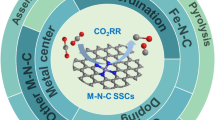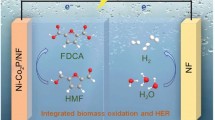Abstract
Electrochemical CO2 reduction reaction (CO2RR) into value-added chemicals/fuels is crucial for realizing the sustainable carbon cycle while mitigating the energy crisis. However, it is impeded by the relatively high overpotential and low energy efficiency due to the lack of efficient electrocatalysts. Herein, we develop an isolated single-atom Ni catalyst regulated strategy to activate and stabilize the iron phthalocyanine molecule (Ni SA@FePc) toward a highly efficient CO2RR process at low overpotential. The well-defined and homogenous catalytic centers with unique structures confer Ni SA@FePc with a significantly enhanced CO2RR performance compared to single-atom Ni catalyst and FePc molecule and afford the atomic understanding on active sites and catalytic mechanism. As expected, Ni SA@FePc exhibits a high selectivity of more significant Faraday efficiency (≥ 95%) over a wide potential range, a high current density of ∼ 252 mA·cm2 at low overpotential (390 mV), and excellent long-term stability for CO2RR to CO. X-ray absorption spectroscopy measurement and theoretical calculation indicate the formation of NiN4-O2-FePc heterogeneous structure for Ni SA@FePc. And CO2RR prefers to occur at the raised N centers of NiN4-O2-FePc heterogeneous structure for Ni SA@FePc, which enables facilitated adsorption of *COOH and desorption of CO, and thus accelerated overall reaction kinetics.

Similar content being viewed by others
References
Chu, S.; Cui, Y.; Liu, N. The path towards sustainable energy. Nat. Mater. 2017, 16, 16–22.
Mitchell, S.; Pérez-Ramírez, J. Single atom catalysis: A decade of stunning progress and the promise for a bright future. Nat. Commun. 2020, 11, 4302.
Obama, B. The irreversible momentum of clean energy. Science 2017, 355, 126–129.
Gu, J.; Hsu, C. S.; Bai, L. C.; Chen, H. M.; Hu, X. L. Atomically dispersed Fe3+ sites catalyze efficient CO2 electroreduction to CO. Science 2019, 364, 1091–1094.
Zheng, T. T.; Jiang, K.; Ta, N.; Hu, Y. F.; Zeng, J.; Liu, J. Y.; Wang, H. T. Large-scale and highly selective CO2 electrocatalytic reduction on nickel single-atom catalyst. Joule 2019, 3, 265–278.
Wu, Y. S.; Jiang, Z.; Lu, X.; Liang, Y. Y.; Wang, H. L. Domino electroreduction of CO2 to methanol on a molecular catalyst. Nature 2019, 575, 639–642.
Wang, Y. C.; Xu, L.; Zhan, L. S.; Yang, P. Y.; Tang, S. H.; Liu, M. J.; Zhao, X.; Xiong, Y.; Chen, Z. Y.; Lei, Y. H. Electron accumulation enables Bi efficient CO2 reduction for formate production to boost clean Zn-CO2 batteries. Nano Energy 2022, 92, 106780.
Zhang, X.; Wu, Z. S.; Zhang, X.; Li, L. W.; Li, Y. Y.; Xu, H. M.; Li, X. X.; Yu, X. L.; Zhang, Z. S.; Liang, Y. Y. et al. Highly selective and active CO2 reduction electrocatalysts based on cobalt phthalocyanine/carbon nanotube hybrid structures. Nat. Commun. 2017, 8, 14675.
Zhong, M.; Tran, K.; Min, Y. M.; Wang, C. H.; Wang, Z. Y.; Dinh, C. T.; De Luna, P.; Yu, Z. Q.; Rasouli, A. S.; Brodersen, P. et al. Accelerated discovery of CO2 electrocatalysts using active machine learning. Nature 2020, 581, 178–183.
Ju, W.; Bagger, A.; Hao, G. P.; Varela, A. S.; Sinev, I.; Bon, V.; Roldan Cuenya, B.; Kaskel, S.; Rossmeisl, J.; Strasser, P. Understanding activity and selectivity of metal-nitrogen-doped carbon catalysts for electrochemical reduction of CO2. Nat. Commun. 2017, 8, 944.
Zhang, T. Y.; Han, X.; Yang, H. B.; Han, A. J.; Hu, E. Y.; Li, Y. P.; Yang, X. Q.; Wang, L.; Liu, J. F.; Liu, B. Atomically dispersed nickel(I) on an alloy-encapsulated nitrogen-doped carbon nanotube array for high-performance electrochemical CO2 reduction reaction. Angew. Chem., Int. Ed. 2020, 59, 12055–12061.
Chen, K. J.; Liu, K.; An, P. D.; Li, H. J. W.; Lin, Y. Y.; Hu, J. H.; Jia, C. K.; Fu, J. W.; Li, H. M.; Liu, H. et al. Iron phthalocyanine with coordination induced electronic localization to boost oxygen reduction reaction. Nat. Commun. 2020, 11, 4173.
Zhang, X.; Wang, Y.; Gu, M.; Wang, M. Y.; Zhang, Z. S.; Pan, W. Y.; Jiang, Z.; Zheng, H. Z.; Lucero, M.; Wang, H. L. et al. Molecular engineering of dispersed nickel phthalocyanines on carbon nanotubes for selective CO2 reduction. Nat. Energy 2020, 5, 684–692.
Hou, Y.; Qiu, M.; Kim, M. G.; Liu, P.; Nam, G.; Zhang, T.; Zhuang, X. D.; Yang, B.; Cho, J.; Chen, M. W. et al. Atomically dispersed nickel-nitrogen-sulfur species anchored on porous carbon nanosheets for efficient water oxidation. Nat. Commun. 2019, 10, 1392.
Sun, X. H.; Tuo, Y. X.; Ye, C. L.; Chen, C.; Lu, Q.; Li, G. N.; Jiang, P.; Chen, S. H.; Zhu, P.; Ma, M. et al. Phosphorus induced electron localization of single iron sites for boosted CO2 electroreduction reaction. Angew. Chem., Int. Ed. 2021, 60, 23614–23618.
Yang, H. B.; Hung, S. F.; Liu, S.; Yuan, K. D.; Miao, S.; Zhang, L. P.; Huang, X.; Wang, H. Y.; Cai, W. Z.; Chen, R. et al. Atomically dispersed Ni(I) as the active site for electrochemical CO2 reduction. Nat. Energy 2018, 3, 140–147.
Jiang, K.; Siahrostami, S.; Zheng, T. T.; Hu, Y. F.; Hwang, S.; Stavitski, E.; Peng, Y. D.; Dynes, J.; Gangisetty, M.; Su, D. et al. Isolated Ni single atoms in graphene nanosheets for highperformance CO2 reduction. Energy Environ. Sci. 2018, 11, 893–903.
Jiang, Z. L.; Wang, T.; Pei, J. J.; Shang, H. S.; Zhou, D. N.; Li, H. J.; Dong, J. C.; Wang, Y.; Cao, R.; Zhuang, Z. B. et al. Discovery of main group single Sb—N4 active sites for CO2 electroreduction to formate with high efficiency. Energy Environ. Sci. 2020, 13, 2856–2863.
Lin, L.; Li, H. B.; Yan, C. C.; Li, H. F.; Si, R.; Li, M. R.; Xiao, J. P.; Wang, G. X.; Bao, X. H. Synergistic catalysis over iron-nitrogen sites anchored with cobalt phthalocyanine for efficient CO2 electroreduction. Adv. Mater. 2019, 31, 1903470.
Ren, S. X.; Joulié, D.; Salvatore, D.; Torbensen, K.; Wang, M.; Robert, M.; Berlinguette, C. P. Molecular electrocatalysts can mediate fast, selective CO2 reduction in a flow cell. Science 2019, 365, 367–369.
Ren, W. H.; Tan, X.; Yang, W. F.; Jia, C.; Xu, S. M.; Wang, K. X.; Smith, S. C.; Zhao, C. Isolated diatomic Ni-Fe metal-nitrogen sites for synergistic electroreduction of CO2. Angew. Chem., Int. Ed. 2019, 58, 6972–6976.
Blöchl, P. E. Projector augmented-wave method. Phys. Rev. B 1994, 50, 17953–17979.
Perdew, J. P.; Burke, K.; Ernzerhof, M. Generalized gradient approximation made simple. Phys. Rev. Lett. 1996, 77, 3865–3868.
Wang, V.; Xu, N.; Liu, J. C.; Tang, G.; Geng, W. T. VASPKIT: A user-friendly interface facilitating high-throughput computing and analysis using VASP code. Comput. Phys. Commun. 2021, 267, 108033.
Jing, H. Y.; Zhu, P.; Zheng, X. B.; Zhang, Z. D.; Wang, D. S.; Li, Y. D. Theory-oriented screening and discovery of advanced energy transformation materials in electrocatalysis. Adv. Powder Mater. 2021, 100013.
Zhou, H.; Yang, T.; Kou, Z. K.; Shen, L.; Zhao, Y. F.; Wang, Z. Y.; Wang, X. Q.; Yang, Z. K.; Du, J. Y.; Xu, J. et al. Negative pressure pyrolysis induced highly accessible single sites dispersed on 3D graphene frameworks for enhanced oxygen reduction. Angew. Chem., Int. Ed. 2020, 59, 20465–20469.
Zhu, Z. J.; Yin, H. J.; Wang, Y.; Chuang, C. H.; Xing, L.; Dong, M. Y.; Lu, Y. R.; Casillas-Garcia, G.; Zheng, Y. L.; Chen, S. et al. Coexisting single-atomic Fe and Ni sites on hierarchically ordered porous carbon as a highly efficient ORR electrocatalyst. Adv. Mater. 2020, 32, 2004670.
Yang, H. P.; Lin, Q.; Zhang, C.; Yu, X. Y.; Cheng, Z.; Li, G. D.; Hu, Q.; Ren, X. Z.; Zhang, Q. L.; Liu, J. H. et al. Carbon dioxide electroreduction on single-atom nickel decorated carbon membranes with industry compatible current densities. Nat. Commun. 2020, 11, 593.
Chen, Y. J.; Gao, R.; Ji, S. F.; Li, H. J.; Tang, K.; Jiang, P.; Hu, H. B.; Zhang, Z. D.; Hao, H. G.; Qu, Q. Y. et al. Atomic-level modulation of electronic density at cobalt single-atom sites derived from metal—organic frameworks: Enhanced oxygen reduction performance. Angew. Chem., Int. Ed. 2021, 60, 3212–3221.
Yang, Q. H.; Yang, C. C.; Lin, C. H.; Jiang, H. L. Metal—organic framework-derived hollow N-doped porous carbon with ultrahigh concentrations of single Zn atoms for efficient carbon dioxide conversion. Angew. Chem., Int. Ed. 2019, 58, 3511–3515.
Zhang, B. X.; Zhang, J. L.; Shi, J. B.; Tan, D. X.; Liu, L. F.; Zhang, F. Y.; Lu, C.; Su, Z. Z.; Tan, X. N.; Cheng, X. Y. et al. Manganese acting as a high-performance heterogeneous electrocatalyst in carbon dioxide reduction. Nat. Commun. 2019, 10, 2980.
Luo, F.; Roy, A.; Silvioli, L.; Cullen, D. A.; Zitolo, A.; Sougrati, M. T.; Oguz, I. C.; Mineva, T.; Teschner, D.; Wagner, S. et al. P-block single-metal-site tin/nitrogen-doped carbon fuel cell cathode catalyst for oxygen reduction reaction. Nat. Mater. 2020, 19, 1215–1223.
Zang, W. J.; Sun, T.; Yang, T.; Xi, S. B.; Waqar, M.; Kou, Z. K.; Lyu, Z.; Feng, Y. P.; Wang, J.; Pennycook, S. J. Efficient hydrogen evolution of oxidized Ni—N3 defective sites for alkaline freshwater and seawater electrolysis. Adv. Mater. 2021, 33, 2003846.
Yan, C. C.; Li, H. B.; Ye, Y. F.; Wu, H. H.; Cai, F.; Si, R.; Xiao, J. P.; Miao, S.; Xie, S. H.; Yang, F. et al. Coordinatively unsaturated nickel-nitrogen sites towards selective and high-rate CO2 electroreduction. Energy Environ. Sci. 2018, 11, 1204–1210.
Voiry, D.; Shin, H. S.; Loh, K. P.; Chhowalla, M. Low-dimensional catalysts for hydrogen evolution and CO2 reduction. Nat. Rev. Chem. 2018, 2, 0105.
Kong, X. D.; Ke, J. W.; Wang, Z. Q.; Liu, Y.; Wang, Y. B.; Zhou, W. R.; Yang, Z. W.; Yan, W. S.; Geng, Z. G.; Zeng, J. Co-based molecular catalysts for efficient CO2 reduction via regulating spin states. Appl. Catal. B:Environ. 2021, 290, 120067.
Liu, X.; Jiao, Y.; Zheng, Y.; Jaroniec, M.; Qiao, S. Z. Building up a picture of the electrocatalytic nitrogen reduction activity of transition metal single-atom catalysts. J. Am. Chem. Soc. 2019, 141, 9664–9672.
Bénisvy, L.; Halut, S.; Donnadieu, B.; Tuchagues, J. P.; Chottard, J. C.; Li, Y. Monomeric iron(II) hydroxo and iron(III) dihydroxo complexes stabilized by intermolecular hydrogen bonding. Inorg. Chem. 2006, 45, 2403–2405.
Hikichi, S.; Ogihara, T.; Fujisawa, K.; Kitajima, N.; Akita, M.; Moro-Oka, Y. Synthesis and characterization of the benzoylformato ferrous complexes with the hindered tris(pyrazolyl)borate ligand as a structural model for mononuclear non-heme iron enzymes. Inorg. Chem. 1997, 36, 4539–4547.
Chen, S. H.; Li, W. H.; Jiang, W. J.; Yang, J. R.; Zhu, J. X.; Wang, L. Q.; Ou, H. H.; Zhuang, Z. C.; Chen, M. Z.; Sun, X. H. et al. MOF encapsulating N-heterocyclic carbene-ligated copper single-atom site catalyst towards efficient methane electrosynthesis. Angew. Chem., Int. Ed. 2022, 61, e202114450.
Wang, Y. N.; Zheng, Y.; Han, C.; Chen, W. Surface charge transfer doping for two-dimensional semiconductor-based electronic and optoelectronic devices. Nano Res. 2021, 14, 1682–1697.
Acknowledgments
H. X. Z. acknowledges funding from the Alexander von Humboldt Foundation. This work was supported by the National Natural Science Foundation of China (No. 21725103), National Key R&D Program of China (No. 2019YFA0705704), the Strategic Priority Research Program of the Chinese Academy of Sciences (No. XDA21010210), Jilin Province Science and Technology Development Plan Funding Project (No. 20200201079JC), Changchun Science and Technology Development Plan Funding Project (No. 19SS010), Jilin Province Capital Construction Funds Project (No. 2020C026-1), and the K. C. Wong Education Foundation (No. GJTD-2018-09).
Author information
Authors and Affiliations
Corresponding author
Electronic Supplementary Material
12274_2022_4197_MOESM1_ESM.pdf
Ligand centered electrocatalytic efficient CO2 reduction reaction at low overpotential on single-atom Ni regulated molecular catalyst
Rights and permissions
About this article
Cite this article
Wang, J., Hao, Q., Zhong, H. et al. Ligand centered electrocatalytic efficient CO2 reduction reaction at low overpotential on single-atom Ni regulated molecular catalyst. Nano Res. 15, 5816–5823 (2022). https://doi.org/10.1007/s12274-022-4197-6
Received:
Revised:
Accepted:
Published:
Issue Date:
DOI: https://doi.org/10.1007/s12274-022-4197-6




